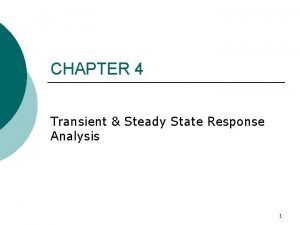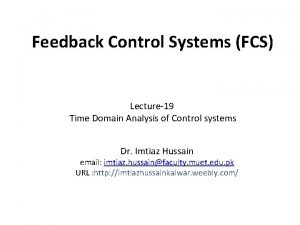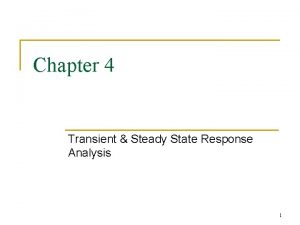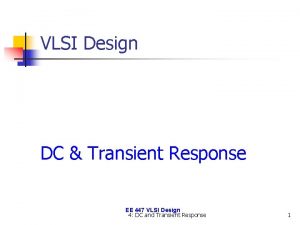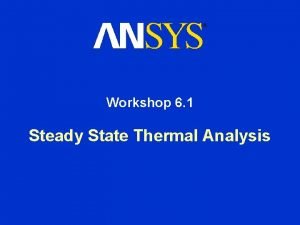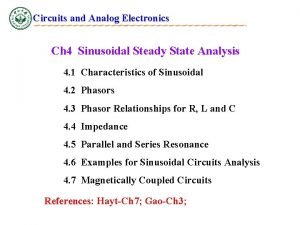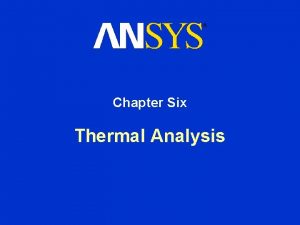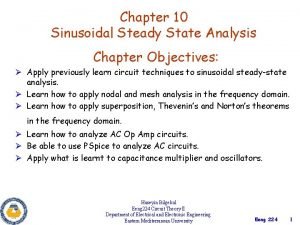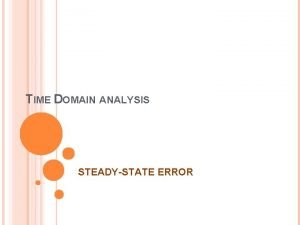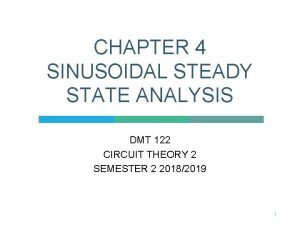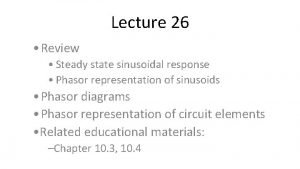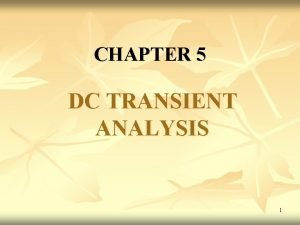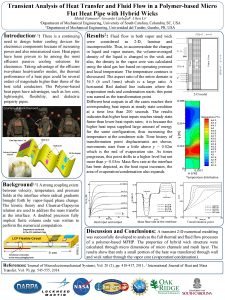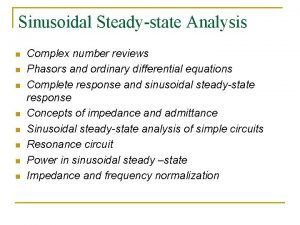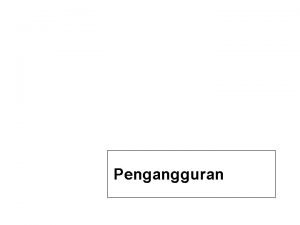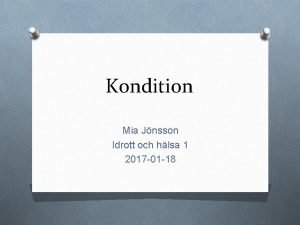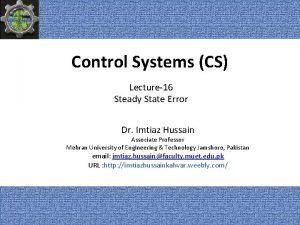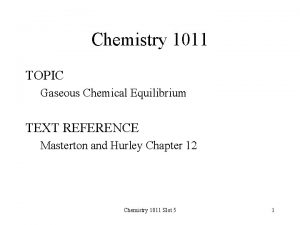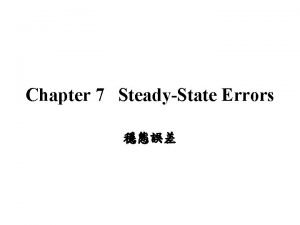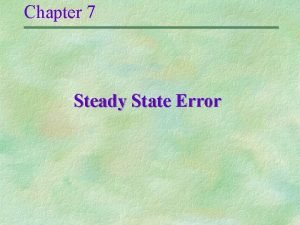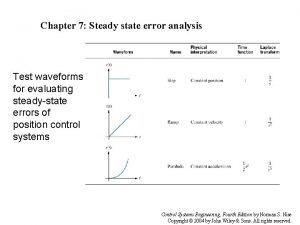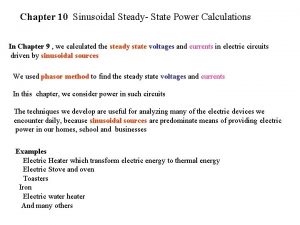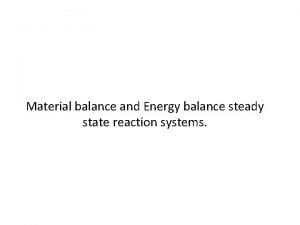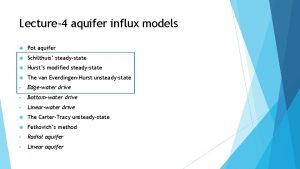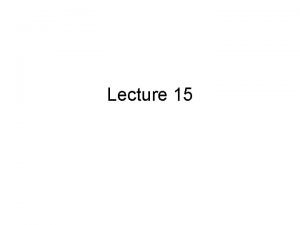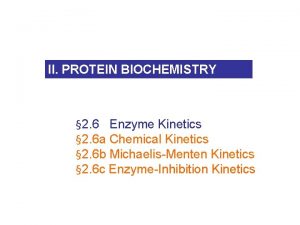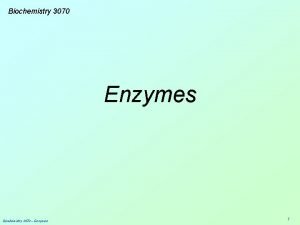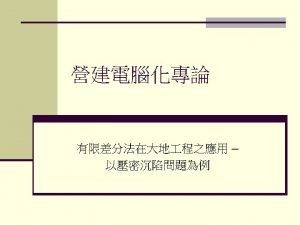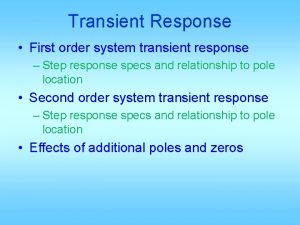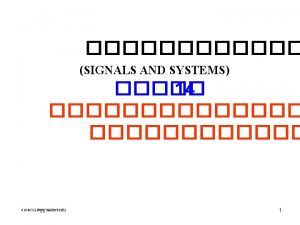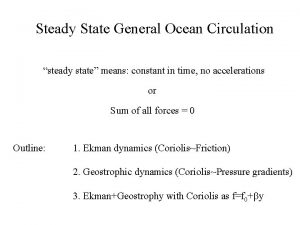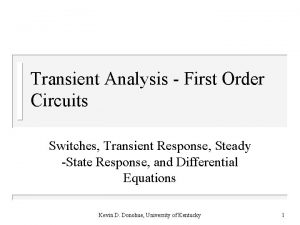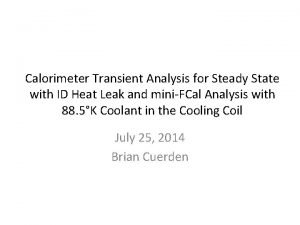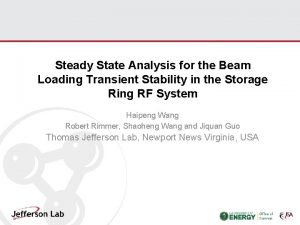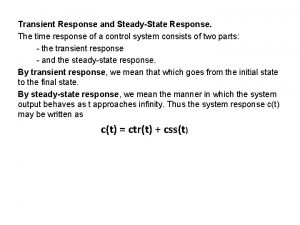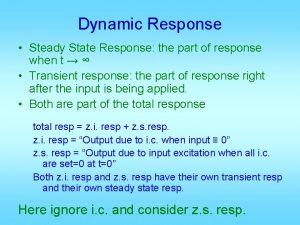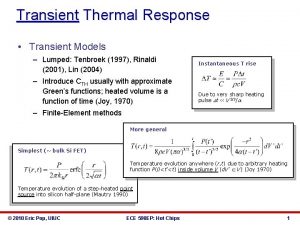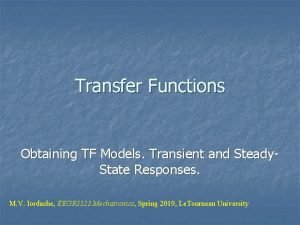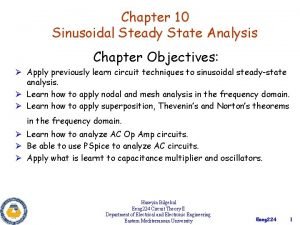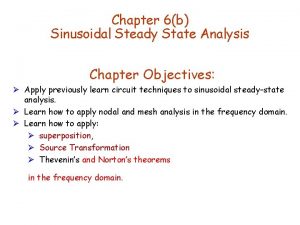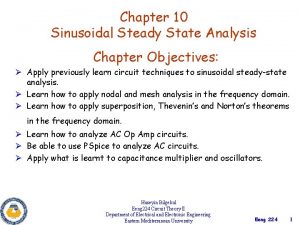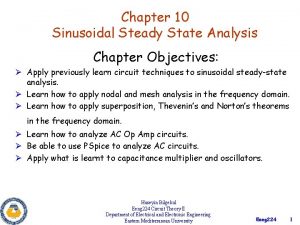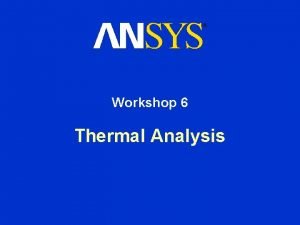Chapter 4 Transient Steady State Response Analysis 1
































- Slides: 32

Chapter 4 Transient & Steady State Response Analysis 1

Announcements!!! n n Textbooks – 2 copies available Price of textbooks : Old : -RM 75. 70, New: RM 71. 50. Your balance will be returned. Test 1 result: Insya Allah by Thursday. SMS me for confirmation Today’s arrangement Screen 1 11 8 5 2 12 9 6 3 13 10 7 4 2

Previous Class n Chapter 4: q q First Order System Second Order System 3

Today’s class n n Routh-Hurtwitz Criterion Steady-state error 4

Routh-Hurwitz Criterion To check for stability of a system 5

Stability Ø in order to know the location of the poles, we need to find the roots of the closed-loop characteristic equation. Ø It turned out, however, that in order to judge a system's stability we don't need to know the actual location of the poles, just their sign. that is whether the poles are in the right-half or left-half plane. Ø The Hurwitz criterion can be used to indicate that a characteristic polynomial with negative or missing coefficients is unstable. Ø The Routh-Hurwitz Criterion is called a necessary and sufficient test of stability because a polynomial that satisfies the criterion is guaranteed to stable. The criterion can also tell us how many poles are in the right-half plane or on the imaginary axis. 6

Stability q need to construct a Routh array. Consider the system shown in the Figure. The closed-loop characteristic equation is: • The Routh array is simply a rectangular matrix with one row for each power of s in the closed-loop characteristic polynomial 7

Stability Table 1: Starting layout for Routh array 8

Stability Table 2: Completed Routh array 9

Stability The Routh-Hurwitz Criterion: The number of roots of the characteristic polynomial that are in the right-half plane is equal to the number of sign changes in the first column of the Routh Array. If there are no sign changes, the system is stable. Example: Test the stability of the closed-loop system 10

Stability Solution: Since all the coefficients of the closed-loop characteristic equation s 3 + 10 s 2 + 31 s + 1030 are present, the system passes the Hurwitz test. So we must construct the Routh array in order to test the stability further. 11

Stability For clarity, we can rewrite the array: 12

Stability and now it is clear that column 1 of the Routh array is: First sign changes Second sign changes v and it has two sign changes (from 1 to -72 and from -72 to 103). Hence the system is unstable with two poles in the right-half plane. 13

Stability Special Case: 1. a zero may appear in the first column of the array o Zero Only in the First Column 2. a complete row can become zero o Entire Row Is Zero 14

Stability (Special Case 1) Consider the control system with closed-loop transfer function: Routh array will be: Considering just the sign changes in column 1: • If is chosen positive there are two sign changes. If is chosen negative there also two sign changes. Hence the system has two poles in the right-half plane and it doesn't matter whether we chose to approach zero 15 from the positive or the negative side.

Stability (Special Case 2) Routh array will be: divide by ‘ 7’ for convenience Consider the control system with closed-loop transfer function: replace the zero row with a row formed from the coefficients of the derivative: divide by ‘ 4’ for convenience Differentiate There are no sign changes in the completed Routh array, hence the system is stable. 16

Example 1: Construct a Routh table and determine the number of roots with positive real parts for the equation; Solution: ü Since there are two changes of sign in the first columm of Routh table, the equation above have two roots at right side (positive real parts). 17

Example 2: The characteristic equation of a given system is: What restrictions must be placed upon the parameter K in order to ensure that the system is stable? Solution: For the system to be stable, 60 – 6 K < 0, or k < 10, and K > 0. Thus 0 < K < 10 18

Steady State Error Analysis 19

Test Waveform for evaluating steadystate error 20

Steady-state error analysis R(s) G(s) - R(s) C(s) E(s) + Unity feedback H(s)=1 E(s) + - C(s) G(s) Non-unity feedback H(s)≠ 1 H(s) 21

Steady-state error analysis For unity feedback system: System error For a non-unity feedback system: Actuating error 22

Steady-state error analysis Consider a unity feedback system, system if the inputs are step response, ramp & parabolic (no sinusoidal input). We want to find the steady-state error Where, By Final Value Theorem: 23

Steady-state error analysis Consider Unity Feedback System (1) (2) Substitute (2) into (1) (3) 24

Steady-state error analysis Based on equation (3), it can be seen that E(s) depends on: (a) Input signal, R(s) (b) G(s), open loop transfer function Now, assume: type N Cases to be considered: 25

Case (A): Input is a unit step R(s)=1/s where “Static Position Error Constant” 26

If N = 0, Kp = constant If N ≥ 1, Kp = infinite For unit step response, as the type of system increases (N ≥ 1), the steady state error goes to zero 27

Case (B): Input is a unit ramp R(s)=1/s 2 where “Static Velocity Error Constant” 28

If N = 0, If N =1, Kv = finite If N ≥ 2, Kv = infinite For unit ramp response, the steady state error in infinite for system of type zero, finite steady state error for system of type 1, and zero steady state error for systems with type greater or equal to 2. 29

Case (C): Input is a parabolic, R(s)=1/s 3 where “Static Acceleration Error Constant” 30

If N = 0, If N =1, Ka = 0 If N = 2, Ka = constant If N ≥ 3 , Ka = infinite Increasing system type (N) will accommodate more different inputs. 31

Example 3 R(s) C(s) + - If r(t) = (2+3 t)u(t), find the steady state error (ess) for the given system. Solution: 32
 Steady state response example
Steady state response example Steady state response in control system
Steady state response in control system Hurtwitz
Hurtwitz Transient response in vlsi
Transient response in vlsi Rw + vo c inverter transient response vod inverte...
Rw + vo c inverter transient response vod inverte... Yshss
Yshss What is steady-state thermal analysis?
What is steady-state thermal analysis? Sinusoidal steady state analysis of coupled circuits
Sinusoidal steady state analysis of coupled circuits What is steady-state thermal analysis?
What is steady-state thermal analysis? Sinusoidal steady state analysis practice problems
Sinusoidal steady state analysis practice problems Steadystate error
Steadystate error Sinusoidal steady state analysis
Sinusoidal steady state analysis Steady state sinusoidal analysis using phasors
Steady state sinusoidal analysis using phasors Dc transient analysis
Dc transient analysis Transient analysis thermodynamics
Transient analysis thermodynamics Sinusoidal steady state
Sinusoidal steady state Secara matematis tingkat pengangguran steady state adalah
Secara matematis tingkat pengangguran steady state adalah Mitokondre
Mitokondre Nicole menten
Nicole menten In a flow process the work transfer may be of which type
In a flow process the work transfer may be of which type In a normal operations/steady state eoc activation level,
In a normal operations/steady state eoc activation level, Static error constant formula
Static error constant formula Steady state vs equilibrium
Steady state vs equilibrium Michaelis menten steady state
Michaelis menten steady state System type 0 1 2
System type 0 1 2 Steady state error with disturbance
Steady state error with disturbance Steady state error table
Steady state error table Sinusoidal steady state power calculations
Sinusoidal steady state power calculations Steady ch t15
Steady ch t15 Schilthuis steady state model
Schilthuis steady state model Steady state approximation in chemical kinetics
Steady state approximation in chemical kinetics Michaelis menten equation and lineweaver burk plot
Michaelis menten equation and lineweaver burk plot What are 3 characteristics of enzymes
What are 3 characteristics of enzymes
